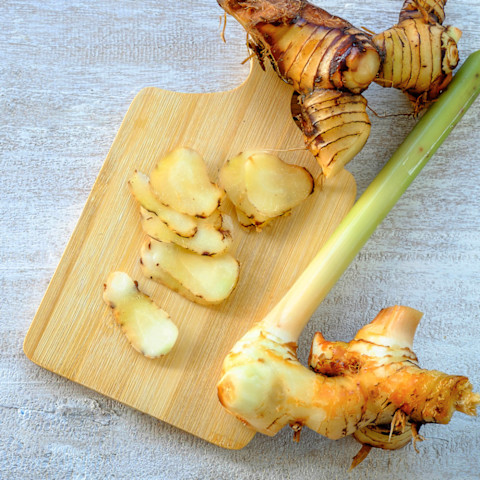The (Vegan!) Anti-Inflammatory, Age-Reversing Food You Should Be Eating — But Aren't
Hippocrates was right when he said that "all disease beings in the gut." In fact, you do not have to have gut symptoms to have gut problems. Even seemingly unrelated health problems such as brain fog, anxiety, skin issues, and even autoimmune conditions all have their roots in gut dysfunction. Because of this fact, healing and supporting your gut should be on the top of your list when it comes to managing your overall health.
As a functional medicine practitioner and best-selling author, it is my job to work toward healing the body from the inside out through natural remedies. I am well-versed in not only discovering the underlying cause of a person's health problems but also how to go about healing them naturally. One of my favorite gut-healing tools, which I talk about a lot, is bone broth. Rich in collagen and other nutrients, it is one of my go-to tools for anyone looking to rebuild gut function and heal themselves from leaky gut syndrome, candida overgrowth, SIBO, and other health problems.
However, many people want a plant-based alternative to heal their gut. As I have seen through many years in my practice, not very many plant-eaters are too excited when I suggest having serving upon serving of steaming animal bone broth on a regular basis—no matter how beneficial it can be to their health. So, what's a health-conscious plant lover to do?
Enter galangal broth. Not to be confused with ginger, galangal is its own root but still part of the same rhizome family of plants, which makes its appearance to ginger very similar. But while they may look the same, they each have their own unique taste and texture. Unlike regular ginger, galangal can only be sliced, not grated, due to its harder exterior. Galangal also has a much stronger flavor than the spicy taste of ginger—galangal packs a punch to the taste buds with its sharp, extra citrusy, piney flavor. Galangal is also referred to as Thai ginger due to its popularity in Thai, Malaysian, and Indonesian cuisines and has been used for centuries in ayurvedic medicine and remedies in other Asian cultures.
What the galangal root lacks in collagen and other nutrients found only in bone broth it makes up for with its other powerful compounds that work to heal the gut through various means. Without a doubt, galangal broth is one of my top ways to heal the gut. Here's why:
1. It's anti-inflammatory.
Inflammation is both a cause and an effect of poor gut health. Multiple studies have shown galangal's ability to calm inflammation throughout the body by down-regulating1 pro-inflammatory cytokines IL-6 and the inflammatory pathway NF-kb due to its phytonutrient content2.
2. It's antibacterial and antifungal.
Bacterial imbalances in the microbiome also contribute to gut problems and further perpetuate inflammation and other health problems. One of the most common bacterial infections in the world is H. pylori with this specific strain of bacteria having been linked to stomach ulcers and other gut problems. Galangal has been shown to help relieve ulcers as well as eliminate3 the presence of this bacteria. It has also been shown to fight off4 other powerful bacteria such as E. coli, clostridium, staphylococcus, and salmonella.

3. It enhances autophagy.
Autophagy is your body's process of clearing out old and damaged cells to make way for younger, healthier cells. New research has shown that autophagy is necessary to regulate the proper balance of bacteria in the gut and maintain a healthy gut lining, and galangal has been shown5 to directly induce the autophagy process.
Needless to say, galangal has some next-level health benefits for anyone looking to heal their gut—regardless of whether your diet is plant-based or not. But because galangal broth isn't derived from bones, one other benefit of this type of broth is that it has a much shorter preparation time due to the fact that it doesn't need as much time to cook out the nutrients from the bones. What would normally take 24 to 48 hours of simmering with bone broth takes only between 30 minutes and an hour with galangal broth.
Since it also lacks collagen, it is not gelatinous and is, therefore, a lighter broth than traditional bone broth. This can actually be easier on some people's digestion as well. So, whether you are a vegetarian or vegan looking for an alternative to bone broth, want to switch up your regular broth routine, or want to add in another gut-healing superfood, look no further than galangal broth.
Fresh galangal can be found at health food markets like Whole Foods, and it is also sold online. If you can't find fresh galangal, you can also buy the dried, ground variety. Generally, for every tablespoon of fresh galangal use a quarter-teaspoon of dried, ground galangal.
Because this broth is typically made with various other Asian spices, it has a distinct flavor similar to Thai cuisine. This recipe is a great way to heal your gut and curb your takeout cravings all in one powerful and delicious meal.
Galangal Broth
Makes 3 quarts
Ingredients
- 12 cups vegetable broth
- 3 stalks lemongrass
- 1-inch piece galangal, sliced into rounds
- 3 green onions, sliced
- ½ teaspoon sea salt
- 1 teaspoon ground pepper
- 3 stalks celery (add celery greens at the top of the stock as well for added nutrients)
- 4 pieces kaffir lime leave
- 3 to 4 sprigs cilantro, for garnish
Method
- Heat the vegetable stock in a large soup pot over medium to high heat, and bring to a boil.
- When boiling, add the lemongrass, galangal, green onions, salt, pepper, celery, and kaffir lime leaves.
- Let boil for 10 minutes.
- Remove from the heat and let stand for 20 minutes to allow the broth to absorb the nutrients and flavors.
- Strain the vegetables and season with additional salt and pepper to taste.
- Garnish with fresh cilantro, and serve hot.
Note: Once cooled, this can be stored in jars and frozen for later use.

